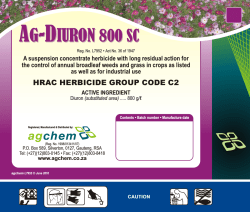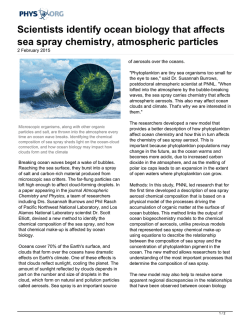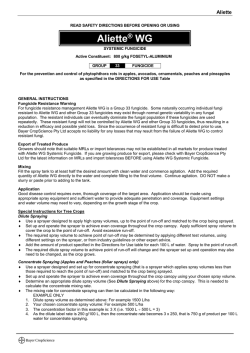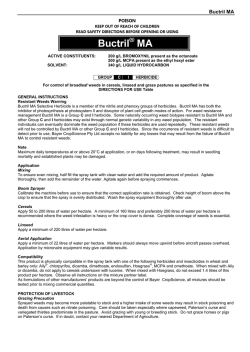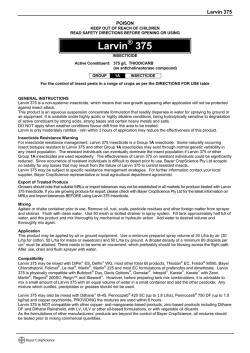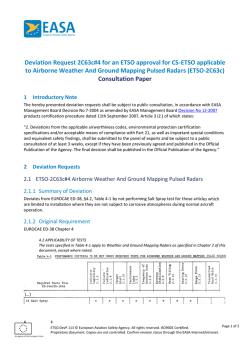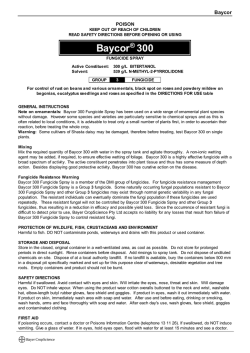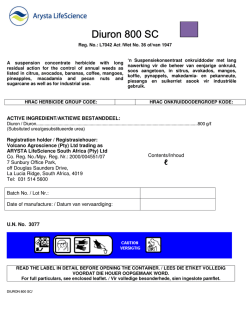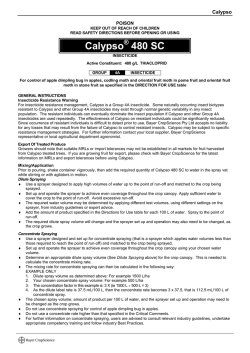
CIPLASATE 360 - Avocado.co.za
CIPLASATE 360 Reg No. L4774 Act. No. 36 of 1947 A soluble concentrate post emergence non-selective systemic herbicide for the control of annual and perennial weeds in crops and industrial areas as indicated. ACTIVE INGREDIENT: Glyphosate (acid equivalent)……….360 g/ℓ Glyphosate (isopropylamine salt)…. 480 g/ℓ WARNINGS • • • • • • • • Handle with care. Poisonous if swallowing. Irritating to eyes and skin. CIPLASATE 360 can be corrosive to zinc-lined spray tanks and other metal equipment. Thoroughly wash all spray equipment after use. Do not mix, store or apply CIPLASATE 360 solutions in galvanised steel or unlined steel (except stainless steel) containers or spray tanks. CIPLASATE 360 can react with such containers to produce hydrogen gas which may form a highly combustible and explosive gas mixture. Aerial application: notify all inhabitants in the immediate vicinity of the area to be sprayed and issue the necessary warnings. Store away from food, feed, seed, fertilizers and other agricultural chemicals. Keep out of reach of children, animals uninformed persons. Re-entry: do not enter treated area until spray deposit has dried unless wearing protective clothing. Although this product has been extensively tested under a large variety of conditions, the registration holder does not warrant that this product will be effective under all conditions. The activity and effect thereof may be affected by factors such as abnormal soil, climatic and storage conditions, quality of dilution water, compatibility with other substances not indicated on the label and the occurrence of resistance of the weed against the remedy concerned, as well as by the method, time and accuracy of application. The registration holder furthermore does not accept responsibility for damage to crops, vegetation, the environment or harm to man or animal, or for lack of performance of the remedy concerned due to failure of the user to follow the label instructions, or to the occurrence of conditions which could not have been foreseen in terms of the registration. Consult the supplier or registration holder in the event of any uncertainty. PRECAUTIONS • • • • • • • Do not breathe fumes or spray mist. In case of accidental contact with skin or eyes, wash immediately with plenty of water, and in the case of eyes get medical attention if necessary. Prevent spray drift and/or contamination onto susceptible or edible crops, grazing or any other areas not under treatment, as this may cause serious crop damage. CIPLASATE 360 is actively absorbed through immature bark and leaves of most plants and trees. Contact with immature bark, such as in trees younger than about four years, can result in serious localised or translocated damage. THEREFORE CONTACT WITH LEAVES, GREEN OR IMMATURE BARK AND FRUIT OF DESIRED PLANTS, WHETHER DIRECT OR BY SPRAY DRIFT, MUST BE AVOIDED. TRIPLE RINSE empty containers in the following manner: invert the empty container over the spray or mixing tank and allow to drain for at least 30 seconds after the flow has slowed down to a drip. Thereafter rinse the container three times with a volume of water equal to a minimum of 10 % of that of the container. Add these rinsings to the contents of the spray tank. Destroy empty container by perforation, flattening and burying. Do not use for any other purpose. Prevent contamination of food, drinking water and eating utensils. RESISTANCE WARNING For resistance management CIPLASATE 360 is a group code G herbicide. Any weed population may contain individuals naturally resistant to CIPLASATE 360 and other group code G herbicides. The resistant individuals can eventually dominate the weed population if these herbicides are used repeatedly. These resistant weeds may not be controlled by CIPLASATE 360 or any other group G herbicides. To delay herbicide resistance: 1 1. 2. Avoid exclusive repeated use of herbicides from the same herbicide group code. Alternate or tank mix with products from different herbicide codes. Integrate control methods (chemical, cultural and biological) into weed control programs. For specific information on resistance management contact you local distributor. DIRECTIONS FOR USE: Use as directed. General information • • • • • • • • • • • • • CIPLASATE 360 is a non-selective systemic herbicide, being active ONLY when applied post-emergence to the foliage and green bark of plants. Action is slow – maximum killing effect is only visible from two weeks after application onwards. Apply when weeds are growing vigorously in spring and summer, or in autumn in the case of difficult to control perennial weeds, when weeds are actively translocating nutrients into roots, bulbs, rhizomes and stolons (See recommendations marked * in list of weeds controlled). It is essential to spot spray regrowth of weeds as recommended to prevent re-infestation of the treated area. Irrigation a few days prior to application of CIPLASATE 360 ensures that weeds are growing actively, resulting in optimum efficacy. Do NOT spray whilst the weeds are wet. Do NOT spray on dormant weeds or weeds under temperature or moisture stress. Rain or irrigation within 6 hours of application can reduce CIPLASATE 360 efficacy on weeds. Do NOT spray on weed foliage covered with a layer of dust. In these situations, apply after a recent rain, but ensure that weeds have dried before spraying. Pesticide run-off onto weeds treated with CIPLASATE 360 in orchards can adversely affect the herbicide’s activity. Do NOT spray pesticides within 12 hours of a CIPLASATE 360 application. CIPLASATE 360 has little or no pre-emergence activity, therefore repeat applications are necessary to control weeds germinating from seed. Ensure that target weeds are fully exposed to the CIPLASATE 360 spray. In mixed weed situations (annuals in amongst the problem perennials) mow or spray out annuals; wait for vigorous regrowth of perennials and then spray. Under certain conditions the addition of a surfactant may be advantageous. Compatibility CIPLASATE 360 is incompatible with most pesticides and agricultural chemicals. Do NOT tank mix with other chemicals except buffers or ammonium sulphate. Application information CIPLASATE 360 can be applied in spray volumes up to 600 ℓ/ha. Various types of equipment are suitable for CIPLASATE 360 applications, such as tractor mounted booms, knapsack sprayers, mistblower and aerial application. • Always ensure that spray equipment is clean and free of rust and dust. • Remove sediments e.g. residues of wettable powder pesticides, from spray tanks before adding CIPLASATE 360. • Always use clean water. Avoid the use of brackish or muddy water, or water with a high colloidal content derived from soils high in organic matter. Where alkaline hard water occurs a buffer should be added according to label recommendations. • Correctly calibrate all sprayers under field conditions. • In situations where drift may be hazardous, use low pressures of 100 to 200 kPa or low drift nozzles when spraying. • It is not necessary to spray to the point of run off, but essential to ensure complete coverage of the target weed. REMEMBER – A FINE EVEN DROPLET DISTRIBUTION ON THE TARGET WEED IS ESSENTIAL FOR GOOD RESULTS. Aerial application Aerial application of CIPLASATE 360 may only be done by a registered aerial application operator using a correctly calibrated, registered aircraft according to the instructions of South African National Standard 10118: The Aerial Application of Agricultural Remedies. Ensure that the spray mixture is distributed evenly over the target area and that the loss of spray material during application is restricted to a minimum. It is therefore essential that the following criteria be met: • • • Volume: a spray mixture volume of 30 to 35 ℓ per hectare is recommended. As this product has not been evaluated at a reduced volume rate, the registration holder cannot guarantee efficacy, or be held responsible for any adverse effects if this product is applied aerially at a lower volume rate than recommended above. Droplet coverage: 30 to 40 droplets per cm² must be recovered at the target area. Droplet size: a droplet spectrum with a VMD of 300 to 350 microns is recommended. Limit the production of fine droplets less than 150 microns (high drift and evaporation potential) to a minimum. 2 • • • • • Flying height: maintain the height of the spray boom at 3 to 4 meters above the target. Do not spray when aircraft dives, is in a climb or when banking Use suitable atomising equipment that will produce the desired droplet size and coverage, but which will ensure the minimum loss of product. The spraying system must produce a droplet spectrum with the lowest possible Relative Span. Position all the atomisers within the inner 60 to 75 % of the wingspan to prevent droplets from entering the wingtip vortices. The difference in temperature between the wet and dry bulb thermometers, of a whirling hygrometer, should not exceed 8 °C. Stop spraying if the wind speed exceeds 15 km/h. Stop spraying under turbulent, unstable and dry conditions during the heat of the day. Spraying under temperature inversion conditions (spraying in or above the inversion layer) and/or high humidity conditions (relative humidity 80 % and above) may lead to the following: • reduced efficacy due to suspension and evaporation of small droplets in the air (inadequate coverage). • damage to other sensitive crops and/or non-target areas through drifting of the suspended spray cloud away from the target field. • • Ensure that the aerial spray operator knows exactly which fields to spray. Obtain an assurance from the aerial spray operator that the above requirements will be met and that relevant data will be compiled in a logbook and kept for future reference. • • Surfactants / additives For optimum results, a minimum of 1,5 % CIPLASATE 360 solution in the total spray volume is recommended. Where the CIPLASATE 360 concentration is less than 1,5 % of the total spray volume, it is recommended to add surfactant to the spray volume. An alternative to surfactants is ammonium sulphate dissolved in the spray water at 2,0 kg/100 ℓ spray volume (2 %). Control of perennial and noxious invader weeds Perennial grasses, and perennial broadleaf weeds and sedges controlled by CIPLASATE 360. ES=Early Spring S= Summer T= Application timing A=Autumn W=Winter Percentage sprays are based on the following: 1. 2. 3. 4. Knapsack sprayer delivering 200 ℓ/ha. Mistblower delivering 150 ℓ/ha. For greater volumes than 1 and 2 above, adjust percentages accordingly up to a maximum of 600 ℓ/ha. Percentage spray recommendations always refer to a % spray made up of litres of CIPLASATE 360 in 100 ℓ water, e.g. 1,5 % solution = 1,5 ℓ CIPLASATE 360 in 100 ℓ water. T S/A Port Jackson willow Acacia saligna A/ES Weeping love grass Eragostis curvula S Or 1,5 % solution. Wild grain sorghum Sorghum bicolor S Or 1,5 % solution. Black wattle Acacia mearnsii S Ink Berry Phytolacca heptandra S RATE ℓ/ha REMARKS Or 1,5 % solution. Large trees: cut back stems to ± 20 cm from soil level. Wait until regrowth is knee height before spraying. Spray seedlings up to 1 m high using a 0,5 % solution. Spray seedlings only: bipinnate leaf stage 2,0 ℓ /ha; seedlings up to 60 cm high 4,0 ℓ/ha. Or 1,5 % solution. Or 3,0 % solution as a cut stump treatment. Apply immediately after cutting to the cambium region. WEED NAME Bug weed Solanum mauritianum 2,0 3,0 Or 1,5 % solution. Spray wattle up to 1 m in height (knapsack sprayer). Or 1,5 % solution (knapsack sprayer). 3 Mauritius thorn Caesalpinea decapetula S 3,0 Or 1,5 % solution (knapsack sprayer). Plaintain Plantago lanceolate ES Apply before flowering only. Sesbania Sesbania punicea ES Apply 1,5 % solution to seedling plants up to 1 m high. Taller shrubs apply 2,0 % solution. For shrubs and/or tall trees slash and spray regrowth with 1,5 to 2,0 % solution when 1 m high. Small mallow Malva parviflora ES Apply before flowering only. Sorrel Rumex spp ES Apply before flowering only. Johnson grass Sorghum halepense S/A 4,0 Or 1,5 % solution. Follow up spray on regrowth using 3 ℓ/ha or spot spray using 1,5 % solution. Kikuyu Pennisetum clandestinum* S Apply on active growth during summer. Spray regrowth using 3 ℓ/ha or spot spray using 1,5 % solution. Nassella tussock grass Nassella trichotoma W American bramble Rubus spp S/A Apply using high volume application 400 ℓ/ha total mixture. Spot spray regrowth in early spring with a 2 % solution. Or spray using 3 % solution (knapsack sprayer) or 4 % solution (mistblower). Buffalo or Ubabe grass Panicum maximum S Follow up spray on regrowth using 3 ℓ/ha or spot spray using 1,5 % solution. Bush buffalo grass Setaria megaphylla S/A Or spray using 3 % solution (knapsack sprayer) or 4 % solution (mistblower). S/A Apply in autumn and follow up in summer on active regrowth using 4 ℓ/ha or spot spray with 2,0 % solution or apply in summer and follow up in autumn. A Or spray using 3 % solution (knapsack sprayer) or 4 % solution (mistblower). Apply at 20 – 30 % flowering stage. Regrowth should be slashed and the following regrowth treated when it is ± 45 cm high. S/A Apply at flower but before seeds are shed, follow up on regrowth using 3 ℓ/ha or spot spray using 1,5 % solution. S Apply at beginning of flowering. Follow up using 1,5 % solution on regrowth, should this be necessary. Common quick grass Cynodon dactylon* Common reed Phragmites australis Common paspalum Paspalum dilatatum Field bindweed Convolvulus Arvensis 6,0 4 Lantana Lantana camara S/A Purple nutsedge Cyperus rotundus S Yellow nutsedge Cyperus esculentus S Couch paspalum Paspalum paspaloides S Eupatorium Chromolaena odorata 6,0 Or spray using 3 % solution (knapsack sprayer) or 4 % solution (mistblower). Apply at flowering (inorchard crops), spray re-growth with 3 ℓ/ha or spot spray using 1,5 % solution (Feb/Mar). 8,0 Apply at flowering (inorchard crops), spray re-growth with 3 ℓ/ha or spot spray using 1,5 % solution(Feb/Mar). Apply at flowering but before seed shed. Follow up spray on regrowth 4 ℓ/ha or spot spray with 2 % solution. Slash established plants and allow to re-grow to 50–120cm. Spray at 1,0 ℓ per 100 ℓ spray volume (i.e. 1,0 %) to give complete droplet cover of foliage. Previously slashed multistem plants may require a follow-up treatment. S/A Apply 2 ml of a 33 % CIPLASATE 360 solution into each 4- 12 premade holes in the stem of trees with 20–250 cladodes. Consult your representative for more detailed information. Prickly pear Opuntia ficus-indica Non-crop and industrial use Generally 6,0–10,0 ℓ/ha will provide acceptable control of most annual and perennial weeds. Spot spraying of regrowth with a 1,5 % solution may be necessary. For specific weeds, refer above. Specific crop recommendations Prevent spray and spray mist contact with leaves, green and young bark of stems as well as fruit of crops. Spray contact with mature bark on tree stems will not result in crop injury. Allow 10 days after pruning, or the removal of low branches and/or suckers before spraying weeds in perennial crops. CROP Apples, Apricots, Avocados, Bananas, Citrus, Guava, Mangoes, Nectarines, Peaches, Pears, Plums, Prunes, DOSAGE ℓ/ha Annual weeds 1,0 - 3,0 ℓ / h a Perennial weeds See specific rate in the above table REMARKS Dosage rate: use the higher rate on mature weeds. Young trees with green bark (generally younger than 4 years): shield stems from spray contact. Bananas: protect suckers and green stems from spray contact. Application can be made to nursery and mature plants. Deciduous fruit and grapevines Summer rainfall area Annual weeds 1,0 - 3,0 ℓ/ha Dosage rate: use the higher rate on mature weeds. Young trees with green bark: shield stems from spray contact. Vines: apply only to vines older than 2 years. Apply before bud burst as a spray directed on weeds. Perennial weeds See specific rate in the above table 5 Winter rainfall area Annual weeds See above Perennial weeds 9,0 ℓ/ha 9,0 ℓ/ha 4,0 ℓ/ha Arable crop land before planting of crop Annual weeds 1,0 - 3,0 ℓ/ha Perennial weeds See recommendations under weed species. Paspalum paspaloides (Couch paspalum) Cynodon dactylon (Common quick grass) Pennisetum clandestinum (Kikuyu) For perennial weed control in the winter rainfall area, apply in autumn after 75 % natural leaf drop but before the first frosts. Use CIPLASATE 360 after harvesting of previous crop and prior to emergence of new crop. Dosage rate: use the higher rates on annual weeds exceeding the 12 leaf stage. For Coyza spp (horseweed) spray 2-3 ℓ/ha. Use the higher dose on well established plants. For the establishment of firebreaks, either total or tracer lines. Replace trace lines in virgin veld. Wattle re-establishment. Control of noxious and problem weeds. Forestry Sugar cane eradication (minimum tillage) Bush and low trellised vines under 60 cm high: Apply pre-bud burst in spring, 8,0 - 10,0 ℓ/ha 10 % solution 2 % solution CIPLASATE 360 will effectively kill last ratoon sugar cane after it has been harvested and allowed to re-grow height of ± 45 cm, when tillering is complete, and then treated with CIPLASATE 360. Spray actively growing sugar cane when tillers have emerged using 100 – 400 ℓ water/ha. Regrowth can be removed by hand. Contact your distributor for detailed information on all aspects of minimum tillage before spraying. For the spot eradication of diseased (e.g. smut) and off type cane stools. Apply as a directed spray on the target plant foliage. For spot spraying around fields, telephone poles, etc. 6
© Copyright 2024

